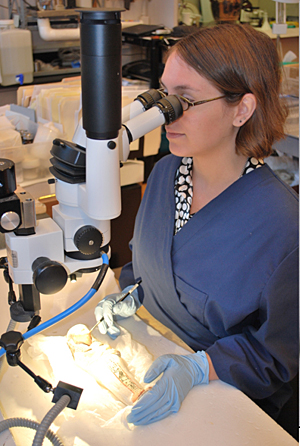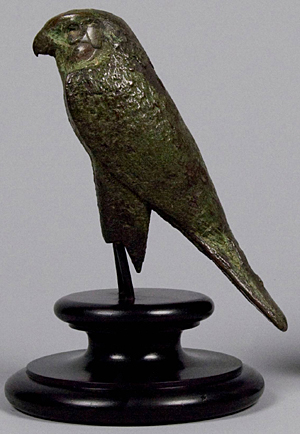
- UD grad interns help preserve mummies, spacesuit, other cultural treasures
- Bringing a saintly portrait back to life in Missouri
- Conserving a knight's shield from ages past
- Käsebier photographs conserved at National Gallery of Canada
- Examining ancient Egyptian mummies at the Walters Art Museum
- Restoring Southwestern pottery at the Arizona State Museum
- Caring for Maryland's first settlement, Armstrong's spacesuit
- Preserving masterpieces at the Walters Art Museum
- 'Big Four' railroad magnate's paintings undergo conservation at Yale
- Studying indigo dyes at the Smithsonian
- Treating a Moorish Islamic ceiling at the Metropolitan Museum of Art
Editor's note: The Winterthur/University of Delaware Program in Art Conservation is one of only five graduate-level conservation programs in the United States. Graduate students in the program spend their third year in an advanced internship at museums and studios around the world.
Here, Lauren McMullen reports on her work at the Walters Art Museum in Baltimore.
10:09 a.m., March 19, 2009----Since my internship began at the Walters Art Museum in September, I have had the pleasure of working on a wide variety of projects. One of my favorites thus far has been documenting, treating, analyzing, and helping to install approximately 20 ancient Egyptian works for a small exhibit titled Mummified. This concentrated show at the Walters explores the ancient Egyptians' fascination with mummification and discusses resurrection symbols and their meaning.
I was able to handle and treat all of the objects in this exhibit--some of which are over 2,500 years old. Mummified contains two animal mummies (a cat and an ibis) on loan from the Johns Hopkins Archaeology Museum, a painted limestone ushabti, a few stone sculptures, several faience amulets and numerous bronze statuettes--some of which are reliquaries for mummified animals. I was able to examine all of these works, most of which only needed minor surface cleaning, but some required more involved treatments.
I was also able to analyze several of the pieces using X-radiography and X-ray fluorescence spectroscopy (XRF). I obtained X-radiographs of the ibis mummy (which is sealed in a clay pot) so these images could be used in the exhibit. I also confirmed the yellow pigment on the limestone ushabti is the light sensitive pigment orpiment with XRF--this is important as light levels will be kept low on this work, and the piece will eventually be rotated out of the exhibit to insure this pigment is not lost. Overall, I gained a greater understanding of ancient Egyptian objects and materials through this wonderful hands-on experience.
While my work with the objects for Mummified was rewarding, I also have had the pleasure to be involved in another fascinating project. I was recently included in a team of people planning the museum's latest installment of Integrating the Arts. This is an interactive Internet site for Baltimore school students in grades K-12 that utilizes artwork in the Walters' collection to teach children about various topics such as math, language, science and social studies. The site currently includes sections for the Ancient, Medieval, and Renaissance collection.
The next section that we have begun planning is specifically for China. I learned a great deal about the pieces selected by the curator for this project, and I was able to aid in developing and refining ideas for interactive and/or print-out activities for each piece. Overall, it was interesting to see the beginning of this endeavor and how the various aspects of the site are taking shape. I am very interested to see how the project develops as I have been thoroughly impressed by all of the existing sections of Integrating the Arts.



